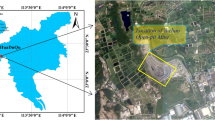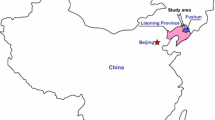Abstract
Slope displacement prediction is an effective means to realize slope disaster early warning and prediction. The scientific and reasonable layout of surface displacement monitoring points is the basis of slope disaster prediction. There are some defects in the determination of the number and location of monitoring points in the process of laying, and there needs to be an effective regulation on how to lay monitoring points according to the overall deformation characteristics of the slope. Therefore, combining the displacement data sequence and spatial location information of the surface displacement monitoring points, based on the correlation of the displacement sequence between different monitoring points, quantifying the spatial correlation of the monitoring points, introducing the normalized spatial correlation scale index, using the cluster analysis method considering the spatial correlation of the monitoring points to divide the deformation area of the slope, and removing the redundant monitoring points in each deformation area according to the result of the deformation area division, Finally, the overall optimization of slope monitoring points is realized. Through this method, slope deformation zoning is more scientific and reasonable, avoiding the influence of human subjectivity on the site and scientifically solving the data overlap phenomenon caused by the unreasonable arrangement of surface displacement monitoring points, thus improving the efficiency and accuracy of slope monitoring. In order to verify the effectiveness of the method, a sand–mudstone interbedded Counter-Tilt excavation slope in southwest China was used as the research object. And 24 monitoring points deployed on this slope were monitored for surface displacement for 13 months. The spatial location of the monitoring points was discussed. The results show that the proposed method of slope deformation zoning and the optimized placement of monitoring points are feasible.


















Similar content being viewed by others
References
Blashfield RK, Aldenderfer MS (1978) The literature on cluster analysis. Multivar Behav Res 13(3):271–295. https://doi.org/10.2307/2528096
Cascini L, Scoppettuolo MR, Babilio E (2022) Forecasting the landslide evolution: from theory to practice. Landslides 19(12):2839–2851. https://doi.org/10.1007/s10346-022-01934-3
Dai K, Li Z, Xu Q, Bürgmann R, Milledge DG, Tomas R, Fan X, Zhao C, Liu X, Peng J, Zhang Q, Wang Z, Qu T, He C, Li D, Liu J (2020) Entering the era of earth observation-based landslide warning systems: a novel and exciting framework. IEEE Geosc Remote Sens Mag 8(1):136–153. https://doi.org/10.1109/MGRS.2019.2954395
Fan Q, Zhu H, Geng J (2015) Monitoring result analyses of high slope of five-step ship lock in the three Gorges project. J Rock Mech Geotech 7(2):199–206. https://doi.org/10.1016/j.jrmge.2015.02.007
Frades I, Matthiesen R (2010) Overview on techniques in cluster analysis. Bioinf Methods Clinic Res. https://doi.org/10.1007/978-1-60327-194-3_5
Frey BJ, Dueck D (2007) Clustering by passing messages between data points. Science 315(5814):972–976. https://doi.org/10.1126/science.1136800
Gariano SL, Guzzetti F (2016) Landslides in a changing climate. Earth-Sci Rev 162:227–252. https://doi.org/10.1016/j.earscirev.2016.08.011
Giorgetti A, Lucchi M, Tavelli E, Barla M, Gigli G, Casagli N, Chiani M, Dardari D (2016) A robust wireless sensor network for landslide risk analysis: System design, deployment, and field testing. IEEE Sens J 16:6374–6386. https://doi.org/10.1109/JSEN.2016.2579263
Hammah RE, Curran JH (1999) On distance measures for the fuzzy K-means algorithm for joint data. Rock Mech Rock Eng 32(1):1–27. https://doi.org/10.1007/s006030050041
Hammah RE, Curran JH (2000) Validity measures for the fuzzy cluster analysis of orientation. IEEE Trans Mach Anal Pattern Anal 22(12):1467–1472. https://doi.org/10.1109/34.895981
Hartigan J, Wong M (1979) Algorithm AS 136: A K-means clustering algorithm. J Royal Stat Soc C-Appl 28(1):100–108. https://doi.org/10.2307/2346830
Hastaoglu KO, Sanli DU (2011) Monitoring Koyulhisar landslide using rapid static GPS: a strategy to remove biases from vertical velocities. Nat Hazards 58:1275–1294. https://doi.org/10.1007/s11069-011-9728-5
Hu Z, Shan W (2016) Landslide investigations in the northwest section of the lesser Khingan range in China using combined HDR and GPR methods. Bull Eng Geol Environ 75(2):591–603. https://doi.org/10.1007/s10064-015-0805-y
Jimenez R (2008) Fuzzy spectral clustering for identification of rock discontinuity sets. Rock Mech Rock Eng 41(6):929. https://doi.org/10.1007/s00603-007-0155-6
Kendall MG (1938) A new measure of rank correlation. Biometrika 30(1/2):81–93. https://doi.org/10.2307/2332226
Kumsar H, Aydan Ö, Tano H, Çelik SB, Ulusay R (2016) An integrated geomechanical investigation, multi-parameter monitoring and analyses of Babadağ-Gündoğdu creep-like landslide. Rock Mech Rock Eng 49:2277–2299. https://doi.org/10.1007/s00603-015-0826-7
Li P, Ji H, Wang B, Huang Z, Li H (2017) Adjustable preference affinity propagation clustering. Pattern Recogn Lett 85:72–78. https://doi.org/10.1016/j.patrec.2016.11.017
Li C, Long J, Liu Y, Li Q, Liu W, Feng P, Li B, **an J (2021) Mechanism analysis and partition characteristics of a recent highway landslide in Southwest China based on a 3D multi-point deformation monitoring system. Landslides 18(8):2895–2906. https://doi.org/10.1007/s10346-021-01698-2
Lin P, Liu X, Hu S, Li P (2016) Large deformation analysis of a high steep slope relating to the Laxiwa Reservoir, China. Rock Mech Rock Eng 49:2253–2276. https://doi.org/10.1007/s00603-016-0925-0
Liu Z, Yu X (2011) Coupled thermo-hydro-mechanical model for porous materials under frost action: theory and implementation. Acta Geotech 6(2):51–65. https://doi.org/10.1007/s11440-011-0135-6
Liu Y, Feng S, Qin Z (2019) Similarity evaluation method of landslide monitoring points based on motion-angle-difference. Rock Soil Mech 40:288–296. https://doi.org/10.1007/s10346-022-01905-8
Liu Z, Liu P, Zhou C, Zhang L (2021a) A theoretical framework for optimization of three-dimensional slope stability monitoring. Eng Geol 295:106436. https://doi.org/10.1016/j.enggeo.2021.106436
Liu F, Yang Z, Deng W, Yang T, Zhou J, Yu Q, Mao Y (2021b) Rock landslide early warning system combining slope stability analysis, two-stage monitoring, and case-based reasoning: a case study. Bull Eng Geol Environ 80:8433–8451. https://doi.org/10.1007/s10064-021-02461-6
Monnet J, Broucke M (2012) The use of a cluster analysis in a Ménard pressuremeter survey. Proceed Institut Civil Eng-Geotec Eng 165(6):367–377. https://doi.org/10.1680/geng.9.00083
Nie L, Li Z, Lv Y, Wang H (2017) A new prediction model for rock slope failure time: a case study in West Open-Pit mine, Fushun, China. Bull Eng Geol Environ 76:975–988. https://doi.org/10.1007/s10064-016-0900-8
Notti D, Cina A, Manzino A, Colombo A, Bendea IH, Mollo P, Giordan D (2020) Low-cost GNSS solution for continuous monitoring of slope instabilities applied to Madonna Del Sasso Sanctuary (NW Italy). Sensors 20(1):289. https://doi.org/10.3390/s20010289
Omkar SN, Khandelwal R, Ananth TVS, Naik G, Gopalakrishnan S (2009) Narayana quantum behaved particle swarm optimization (QPSO) for multi-objective design optimization of composite structures. Expert Syst Appl 36:11312–11322. https://doi.org/10.1016/j.eswa.2009.03.006
Qi Y, Tian G, Bai M, Song L (2023) Study on construction deformation prediction and disaster warning of karst slopes based on grey theory. Bull Eng Geol Environ 82(2):62. https://doi.org/10.1007/s10064-023-03074-x
Qiang XU (2020) Understanding the landslide monitoring and early warning: consideration to practical issues. J Eng Geol 28(2):360–374
Saeidi O, Torabi SR, Ataei M (2014) Prediction of the rock mass diggability index by using fuzzy clustering-based, ANN and multiple regression methods. Rock Mech Rock Eng 47:717–732. https://doi.org/10.1007/s00603-013-0426-3
Shang F, Jiao LC, Shi J, Wang F, Gong M (2012) Fast affinity propagation clustering: a multilevel approach. Pattern Recogn 45(1):474–486. https://doi.org/10.1016/j.patcog.2011.04.032
Song S, Cai D, Feng X, Chen X, Wang D (2011) Safety monitoring and stability analysis of left abutment slope of **** I hydropower station. J Rock Mech Geotech 3(2):117–130. https://doi.org/10.3724/SP.J.1235.2011.00117
Steinley D (2006) Means clustering: a half-century synthesis. Br J Math Stat Psychol 59(1):1–34. https://doi.org/10.1348/000711005X48266
Struyf A, Hubert M, Rousseeuw PJ (1997) Integrating robust clustering techniques in S-PLUS. Comput Stat Data Anal 26(1):17–37. https://doi.org/10.1016/S0167-9473(97)00020-0
Tobler WR (1970) A computer movie simulating urban growth in the Detroit region. Econ Geogr 46:234–240. https://doi.org/10.2307/143141
Tokhmechi B, Memarian H, Moshiri B, Rasouli V, Noubari HA (2011) Investigating the validity of conventional joint set clustering methods. Eng Geol 118:75–81. https://doi.org/10.1016/j.enggeo.2011.01.002
Tseng CH, Chan YC, Jeng CJ, Rau RJ, Hsieh YC (2021) Deformation of landslide revealed by long-term surficial monitoring: a case study of slow movement of a dip slope in Northern Taiwan. Eng Geol 284:106020. https://doi.org/10.1016/j.enggeo.2021.106020
Wang H, Yao X (2016) Objective reduction based on nonlinear correlation information entropy. Soft Comput 20:2393–2407. https://doi.org/10.1007/s00500-015-1648-y
Wang Q, Shen Y, Zhang Y, Zhang J (2004) Fast quantitative correlation analysis and information deviation analysis for evaluating the performances of image fusion techniques. IEEE T Instrum Meas 53:1441–1447. https://doi.org/10.1109/TIM.2004.834094
Wang G, Cao P, Lin H, Zhang Q, Sun S (2007) Determination of optimum monitoring point of slope and safety factor using grey system theory. J Cent South Univ (Sci Technol) 03:574–578. https://doi.org/10.3969/j.issn.1672-7207.2007.03.036
Wang HD, Gao YL, Xue XQ, ** XH, Wang G (2013) Optimal placement of monitoring point at typical landslide. J Jilin Univ (earth Sci Edit) 43(3):856–866. https://doi.org/10.13278/j.cnki.jjuese.2013.03.037
Wang JM, Zhang J, Deng ZB, Wang YT (2014) Slope deformation analyses with space-time Kriging interpolation method. J China Coal Soc 39(5):874–879. https://doi.org/10.13225/j.cnki.jccs.2014.0282
Wehrl A (1978) General properties of entropy. Rev Mod Phys 50:221. https://doi.org/10.1103/RevModPhys.50.221
**an Y, Wei X, Zhou H, Chen N, Liu Y, Liu F, He S (2022) Snowmelt-triggered reactivation of a loess landslide in Yili, **njiang, China: mode and mechanism. Landslides 19(8):1843–1860. https://doi.org/10.1007/s10346-022-01879-7
Xu L, Chen J, Wang Q, Zhou F (2013) Fuzzy C-means cluster analysis based on mutative scale chaos optimization algorithm for the grou** of discontinuity sets. Rock Mech Rock Eng 46:189–198. https://doi.org/10.1007/s00603-012-0244-z
Yang BB, Yin KL, Du J (2018) A model for predicting landslide displacement based on time series and long and short term memory neural network. Chin J Rock Mech Eng 37(10):2334–2343
Yang B, Yin K, Lacasse S, Liu Z (2019) Time series analysis and long short-term memory neural network to predict landslide displacement. Landslides 16(4):677–694. https://doi.org/10.1007/s10346-018-01127-x
Yi X, Feng W, Bai H, Shen H, Li H (2021) Catastrophic landslide triggered by persistent rainfall in Sichuan, China: August 21, 2020, Zhonghaicun landslide. Landslides 18:2907–2921. https://doi.org/10.1007/s10346-021-01701-w
Yu Y, Wang E, Zhong J, Liu X, Li P, Shi M, Zhang Z (2014) Stability analysis of abutment slopes based on long-term monitoring and numerical simulation. Eng Geol 183:159–169. https://doi.org/10.1016/j.enggeo.2014.10.010
Zhang S, Fan Q, Niu Y, Qiu S, Si J, Feng Y, Zhang S, Song Z, Li Z (2023) Two-dimensional deformation monitoring for spatiotemporal evolution and failure mode of Lashagou landslide group Northwest China. Landslides 20(2):447–459. https://doi.org/10.1007/s10346-022-01979-4
Zhao Z (2007) Theory and method research of safety assessment of high rock slope based on displacement information. Dissertation, Hohai University
Zheng Y, Zhao S (2004) Application of strength reduction fem in soil and rock slope. Chin J Rock Mech Eng 23:3381–3388. https://doi.org/10.3321/j.issn:1000-6915.2004.19.029
Funding
The authors acknowledge the support received from the National Natural Science Foundation of China (No. 51969023).
Author information
Authors and Affiliations
Contributions
YL: Investigation, methodology, data curation, visualization, writing–original draft; WZ: Methodology, data curation, writing–review and editing; KZ: Unmanned aerial vehicle (UAV), data curation; QG: funding acquisition; ST, FG: Writing–review and editing.
Corresponding author
Ethics declarations
Conflict of interest
The authors declare that they have no known competing financial interests or personal relationships that could have appeared to influence the work reported in this paper.
Additional information
Publisher's Note
Springer Nature remains neutral with regard to jurisdictional claims in published maps and institutional affiliations.
Rights and permissions
Springer Nature or its licensor (e.g. a society or other partner) holds exclusive rights to this article under a publishing agreement with the author(s) or other rightsholder(s); author self-archiving of the accepted manuscript version of this article is solely governed by the terms of such publishing agreement and applicable law.
About this article
Cite this article
Li, Y., Zhang, W., Zhang, K. et al. Study on slope deformation partition and monitoring point optimization considering spatial correlation. Nat Hazards (2024). https://doi.org/10.1007/s11069-024-06737-4
Received:
Accepted:
Published:
DOI: https://doi.org/10.1007/s11069-024-06737-4




